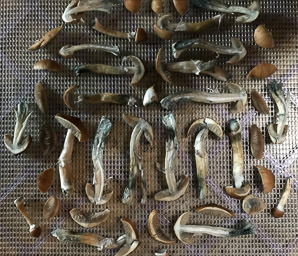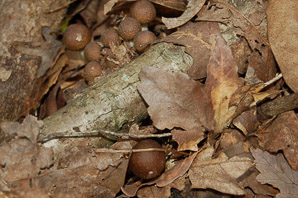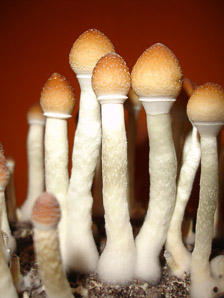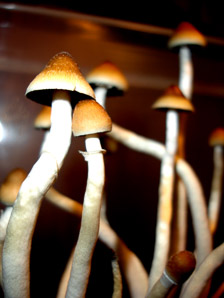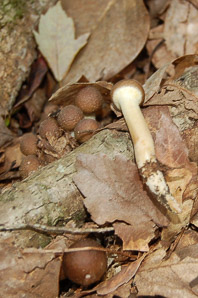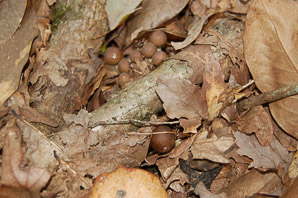
|
Psilocybe cubensis (Earle) Singer Boomers, magic mushrooms, golden tops, shrooms, gold caps
“Magic mushrooms” are among the better known of many varieties of mushrooms with hallucinogenic or other neurotropic effects. They are native to southern North America, Central America, the Caribbean, and many localities throughout the world. There are at least 140 known species of Psilocybe, and dozens or hundreds of other psychoactive mushrooms. Identification: Stalks are 1½-6″ (4-15 cm) tall, and ⅛-½″ (4-15 mm) around. Usually they are white or yellowish-brown, sometimes darkening with age. Caps are ½-3″ (1.5-8 cm) in diameter, rarely as much as 4″ (10 cm), and may be conical, oval, or bell-shaped. The caps may have a raised area in the center called an umbo, and are whitish to yellowish to cinnamon brown. When the flesh is bruised, it turns bluish or blue-green, an unusual feature. (This is actually the result of oxidation of some of the psilocybin.) Mushrooms are often found on dung and manure. The gills are pale at first, darkening to dark purple or black as the mushroom ages. A spore print, produced by leaving the mushroom cap on a sheet of paper until it dries, is black tinged with violet. There are many subvarietes of this mushroom, and related species. Edibility: Hallucinogenic; technically nonpoisonous. Along with psilocybin (4-phosphoryloxy-N,N-dimethyltryptamine) and psilocin (4-hydroxy-N,N-dimethyltryptamine), this species contains at least two other hallucinogens. The concentration of these ingredients varies as a result of mushroom age and growth conditions. For example, psilocin breaks down fairly quickly, while psilocybin does not. Toxic physical reactions and overdoses are rare, but people taking MAOIs (monoamine oxidase inhibitors) typically experience excessively strong (roughly doubled) effects. The mushrooms have a mealy taste. Wild magic mushrooms are quite rare, and other species, sometimes chemically treated, are often substituted by vendors, making it risky to buy them. Medical: Some evidence exists that these mushrooms are effective for treating cluster headaches. They are now being actively researched for possible benefit in treatment of anxiety, depression, and autoimmune conditions of the brain. References:
Arora, David, Mushrooms Demystified, Ten Speed Press, 1986, p. 373 Miller, Jr., Orson K., Mushrooms of North America, E.P. Dutton, 1979, p. 184 Online References:
Shroomery: Magic Mushrooms Demystified Tom Volk's Fungi site, at the Department of Biology at the University of Wisconsin A Worldwide Geographical Distribution of the Neurotropic Fungi, an Analysis and Discussion Www.amazon.com (How to Change Your Mind: What the New Science of Psychedelics Teaches Us About Consciousness, Dying, Addiction, Depression, and Transcendence, by Michael Pollan)
Psilocybe cubensis description by Thomas H. Kent, last updated 10 Aug 2023. © FloraFinder.org. All rights reserved. |
10/10/2012 · By Jacquelyn Boyt The Thai variety. By Dr. Brainfish. · 7/29/2023 · Thailand The Huautla variety. By Dr. Brainfish. · 7/29/2023 · Huautla, Hidalgo, Mexico 10/10/2012 · By Jacquelyn Boyt 10/10/2012 · By Jacquelyn Boyt
|
